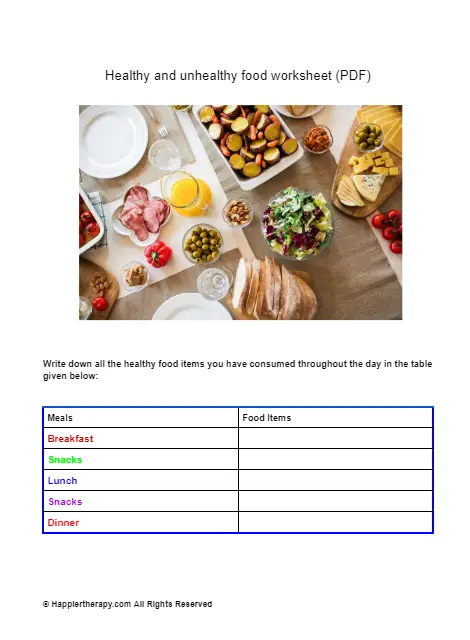Healthy and unhealthy foods sorting worksheet
Premium Content
Access this worksheet and 2,500 mental health worksheets. Cancel anytime
What is the theory behind healthy and unhealthy foods sorting worksheet ?
A balanced diet, which contains a variety of various food categories in the proper amounts, is often the foundation of a healthy and unhealthy foods sorting worksheet. This idea states that a balanced diet should contain a variety of vitamins, minerals, fibre, healthy fats, carbohydrates, and proteins.
Unlock deeper healing — upgrade to Premium now!
Customizable and fillable worksheets
Rights to alter the worksheets
Over 2000 worksheets
Support HappierTherapy
Foods that are high in nutrients and low in added sugars, saturated fats, and sodium are considered healthy, and these would be placed in the “healthy” category. On the other hand, foods that are high in added sugars, saturated fats, and sodium and low in nutrients are considered unhealthy, and these would be placed in the “unhealthy” category.
How will this worksheet help?
This worksheet will help in the following ways:
- Education: The worksheet can enlighten users on the nutritional value of various meals and assist them in making more knowledgeable dietary decisions.
- Setting goals: The worksheet can be used as a jumping off point for establishing goals and monitoring development over time. It can also be used to pinpoint areas where improvements in general health and wellbeing can be made.
- Tracking food choices: The worksheet can be used as a way to monitor food choices and create a balanced diet. It can help individuals to identify patterns in their food choices, such as a tendency to consume too many processed foods or not enough fruits and vegetables.
- Improving overall health: By making more informed food choices, individuals can improve their overall health and well-being.
How to use the worksheet ?
Users are asked to put different food in the groups they belong to by looking at the pictures of the food items given. In this way they will have the knowledge of the macro and micro nutrients of the different foods.
Was this helpful?
References
1.-
Cena, H., & Calder, P. C. (2020). Defining a Healthy Diet: Evidence for The Role of Contemporary Dietary Patterns in Health and Disease. Nutrients, 12(2), 334. https://doi.org/10.3390/nu1202033

 By
By
